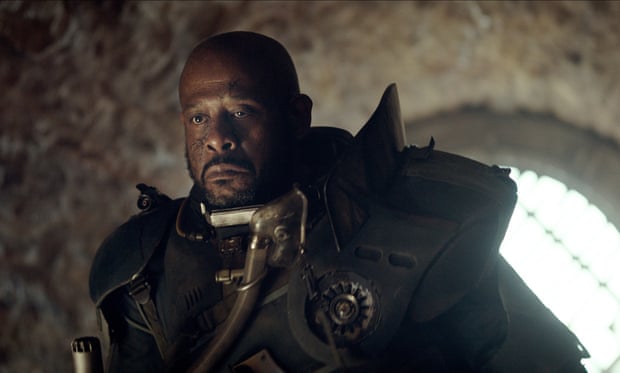This past week, I had the utter delight of participating, in full Jedi Rey cosplay no less, in the 2021 NavyCon. My last panel was a wonderful mix of fellow science fiction nerds and we talked about the intersection of science fiction and military strategy. (If you missed the panel, the replay can be found here). One of the most intriguing questions posed for the panel was, “Is Saw Gerrera a terrorist?” Unfortunately, the panel was only so long and we didn’t have the opportunity to let everyone answer. But, wow, what a great question for exploring such an important topic! This question has nagged at me for the last few days, enough so that I decided to write out my answer and expand on it slightly.
First, who is Saw Gerrera?
I will make the basic assumption that if you are reading the Angry Staff Officer blog, you are at least passing familiar with the Star Wars universe. Saw Gerrera does not appear in the primary nine movies; rather, he appears in the live-action Rogue One: A Star Wars Story and in an animated form in Star Wars Rebels, Clone Wars, and Bad Batch. Admittedly, I haven’t had the 300+ hours (or whatever it really is) to watch every Clone Wars, Rebels, and Bad Batch episode, so I’m relying on several watches of Rogue One and a little Wookiepedia skimming.
Saw Gerrera’s early life as a soldier is covered primarily in the animated series: Clone Wars, Rebels, and Bad Batch. He starts as a rebel resistance fighter on his own homeworld. During his time with these rebels, he is captured, interrogated, and tortured. Once free, he returns to his group a changed man. When viewers see him in Rogue One, he has walked a dark path and represents the chaos of war.
What defines terrorism?
There are many ways one can define terrorism and none of them are perfect for every situation. However, for the purpose of my answer to the Saw Gerrera question, I will work from the most basic definition and state that terrorism is an act or acts intended to cause terror for political gain. Furthermore, terrorists and terrorist groups specifically target non-military targets or targets with no viable military value like civilian non-combatants. Finally, as Audrey Kurth Cronin points out in “How Terrorism Ends,” a terrorist campaign “involves three strategic actors – the group, the government, and the audience.” The last is the key part of this essay because it leaves the definition of terrorism open to the audience, whether they be the civilian populace on his planet or the viewer.
Does Saw Gerrera fit the definition of a terrorist?
Now we reach the real question: is Saw Gerrera a terrorist? To which I answer a qualified “yes” because it will depend on what Star Wars content you’ve consumed. In his early career, which is covered by the animated series, no, he is not. He is a career soldier with human tendencies, notably anger, but he can understand and stay within the bounds of what is morally and ethically right during combat. However, after being tortured by Kalani (Clone Wars), his mind was broken and he begins down a dark and more violent path.
In his later years, he led the Partisans, a militant group on the fringe of the Rebel Alliance know for resorting to extreme tactics. Saw is ultimately censured by Mon Mothma for his brutality and what members of the Partisans do under his leadership. So, if you were a consumer of later timeline animated content, you may be on the cusp of accepting him as a terrorist.
Now we must examine his appearance in Rogue One. His discussion with Jyn Erso indicates she fought in his Partisans from before she was sixteen and abandoned by Saw, implying that she was a child soldier. In Saw Gerrera’s last days and moments, we see him torture Bodhi Rook until Bodhi’s mental capabilities are compromised, an eerie echo of Saw’s own torture at the hands of Kalani. One could argue that Bodhi’s torture was not intended to influence a government but was simply an expedient, if immoral, way to get the information Saw desired. Still, there is a secondary impact on the audience. Anyone who hears that he tortures beings may be more willing to comply with his demands. Given his violence and willingness to torture a man to the point of incapacity for a political end, one should deem him a terrorist at this point in the timeline.
How could the Empire or the Rebel Alliance have dealt with Saw Gerrera?
It seems clear that at the end of his career, Saw Gerrera was a terrorist. So the next question that has nagged at me since the conclusion of NavyCon is how does terrorism end and what ways could Empire or the Rebel Alliance deal with Saw Gerrera?
In “How Terrorism Ends,” Cronin describes six ways in which terrorism can end: decapitation, negotiation, success, failure, repression, and reorientation. Cronin defines decapitation as killing or catching a leader. This case is the easiest to examine as Saw is killed on Jedha. One can assess that his removal from the Partisans was almost negligible as most perished in the destruction of Jedah City. However, as the movie progresses, it’s clear that the Rebellion achieved its goals while the Empire did not.
The five remaining ways in which terrorism ends and their efficacy depends on whether you look at it from the perspective of the Empire or the Rebel Alliance.
The Rebel Alliance had already distanced itself from Saw and the Partisans, censuring them. They would most likely try negotiation, reorientation, or success. If so inclined, Mon Mothma and the Rebel Alliance could attempt to negotiate with Saw and make attempts to bring him and the Partisans back into the fold, re-establishing them as a part of the legitimate political process. Ideally, the Rebel Alliance would make bringing the Partisans back into the fold contingent on the worst and most violent members being tried for their crimes and wringing oaths to follow law and order from the remainder.
If the Rebel Alliance could not negotiate with Saw and his group, they could attempt a campaign to reorient them. The Rebel Alliance may risk losing influence among those sympathetic to their cause if they are seen negotiating with a known terrorist organization, but if they can influence Saw and the Partisans, they might be able to at least halt their violence.
The final way in which the Rebel Alliance might choose to deal with Saw is simply by succeeding. A terrorist organization achieving success in their stated goal is, remarkably, one of the ways in which terrorism ends. When the Rebel Alliance ultimately defeats the Empire, then the goals of Saw and the Partisans have been achieved and they no longer require terrorist tactics. And I would argue, Saw knew, in his final moments, that the Rebels would succeed. In his final scene with Jyn Erso, before Jedah City’s implosion destroys his lair, Saw tells Jyn, “I will run no longer. But you must save yourself. Go! Save the Rebellion! Save the dream.” This seems to acknowledge, on some level, that Saw knew that Jyn’s actions would ultimately bring his stated goals.
His final actions might also show a level of awareness in the extremity of his own actions. An argument could be made that Saw knew that his fringe extremists would never be welcomed by the Rebel Alliance again or that too many would be tried and confined for their terrorist actions and that’s why he elected to remain as Jedah was destroyed. This sense of failure is one of the cases in which the Empire would find success. With Saw accepting he can no longer be part of the group that will achieve success, his acceptance of failure contributes to the end of his terrorism at the hands of the Empire.
The destruction of Jedah City and Saw’s lair can also be viewed as an example of repression and the final way in which the Empire would see his terrorism end. The Empire and Saw Gerrera are diametrically opposed; they would not be able to convince him to negotiate or reorient. Additionally, his success is their failure. This leaves the Empire with the outlet that seems most effective for them: repression, the crushing of terrorism with force. First, they crush the populace of Jedah City and clamp down on the remaining Partisans, then with the newly completed Death Star, they deliver their final blow by destroying the city and surrounding terrain wholly.
Saw Gerrera is a terrorist, but he’s on our side?
It’s been nearly a week since this question first got my gears turning, but I have to conclude that, yes, despite starting in the Star Wars universe as a good and moral character, Saw Gerrera ended as a terrorist. That said, given a little more screen time and a push from inside the Rebel Alliance, he might have been turned away from terrorism and helped achieve the end of the Empire.
Enjoy what you just read? Please share on social media or email utilizing the buttons below.
About the Author: Kera Rolsen is an officer in the U.S. Air Force. She has deployed both with the B-52 and at the CAOC, graduated from and taught at the USAF Weapons School, and is a graduate of the School of Advanced Air and Space Studies. She is currently the Commander of Combat Shield. Puff can be found on Twitter as @KeraRolsen and writes as @AuthorKRPaul, but is “awesomely dorky” in either guise. The views expressed are those of the author and do not necessarily reflect the official policy or position of the Air Force or the U.S. government.
Cover Photo: Saw Gerrera in Rogue One: A Star Wars Story. Allstar/LUCASFILM



